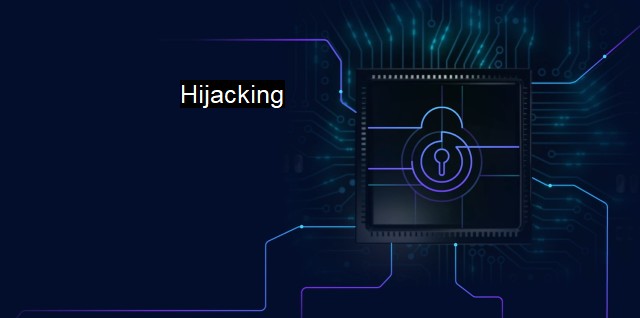What is Hijacking?
Hijacking Techniques in Cybersecurity: Identifying and Protecting Against Covert Attacks on Computer Systems and Web Browsers
"Hijacking" in the context of cybersecurity and antivirus refers to the act of seizing control of a computer system, network, or software application without the user's consent or knowledge. It is a kind of cyberattack similar to burglary or kidnap in the physical world; nefarious individuals infiltrate systems and take over functionalities, often to instigate further malicious activities. This unapproved takeover can have varying degrees of severity and scale, ranging from gaining control over a single user system to infiltrating a whole network of computers or devices.The cyber hijacking phenomenon is a strategic angle of attack where cyber criminals infiltrate business operations, critical infrastructures, private accounts, or other digital systems to carry out diverse malicious exploits. Cybercriminals often conduct such attacks to gather valuable information illegally, manipulate systems for their gain, create nuisance and in some cases disrupt services which can lead to dire consequences.
Various incidents of hijacking have been reported in the past. Email hijacking involves getting unauthorized access to the email accounts of the victims. Browser hijacking involves changing the user's browser settings alongside pushing unwanted advertisements and redirect users to particular websites without their consent. Account hijacking, in this case, criminals get unauthorized access to the victim’s online accounts such as bank accounts, email, or social media accounts.
More potentially damaging forms include session hijacking whereby an attacker intercepts and potentially alters the communication between two parties. Imagine a phone call where a third-party is eavesdropping and dictating the conversation. Another example is DNS hijacking where unscrupulous actors redirect traffic intended for a certain IP address to another IP address, which can often be phony. Similarly, ransomware is another well-known form of hijacking where attackers encrypt users' data and demand a ransom for its safe return.
With unprecedented advancements in technology, cyber hijacking is evolving with more sophisticated methods being used by the perpetrators making them difficult to detect and counter. IoT Device hijacking is now a real threat with many devices beyond just computers, such as Smart TVs, Smart appliances, and mobile phones being vulnerable.
An antivirus is a critical defense against hijacking. It acts as a safety net, scanning, recognizing, isolating, and eliminating threats. Using AI and more advanced methods, antivirus softwares can effectively track suspicious activities, warn users, and counteract the prospective attacks in real time. While antivirus tools form an essential barrier against such malicious activities, due to the constantly adapting nature of cyber threats, they should be supplemented with other protective measures. Regular software updates, strong authentication protocols, and user training can go a long way to ensure comprehensive security.
Education about potential threats, their warning signs, and preventative measures against cyber hijacking is also essential. Cybersecurity is not just about implementing technologies; it's as much about users being aware of possible threats and adopting a more cautious and alert approach while dealing with digital systems and data.
State-of-the-art cybersecurity technologies like intrusion detection systems (IDS), intrusion prevention systems (IPS), and behavior analytics software that identify and react to unusual behaviors within a network can play a significant role in pro-actively combating hijacking attempts.
While hijacking continues to pose a significant threat in comprehensively digital societies, it's a risk that can be actively managed and mitigated with the right tools and correct user habits. Few things can match the peace of mind accompanying a robust cybersecurity strategy and comprehensive knowledge. Protection here starts with understanding the threat and never underestimating the possible impact be it individual or organizational level.
Hijacking is an incessant menace in the digital world. The key to dealing with it effectively lies in constant learning, vigilance, and the right combination of technological interventions and user practices. Enhancing the security posture through collective efforts at every level is pivotal to creating a safer environment in the cyber realm.

Hijacking FAQs
What is hijacking in cybersecurity?
Hijacking in cybersecurity refers to a technique used by hackers to gain unauthorized access to a computer system or network. This involves taking control of an ongoing session or communication between two devices or users, and using it to execute malicious activities.What are the common types of hijacking attacks?
Some of the common types of hijacking attacks include session hijacking, DNS hijacking, clickjacking, and man-in-the-middle attacks.How can I prevent hijacking attacks on my system?
To prevent hijacking attacks, you can take several measures, such as keeping your software and antivirus updated, using strong passwords, avoiding clicking on suspicious links, and using secure networks. You can also use encryption and two-factor authentication to enhance your system's security.What should I do if my system is hijacked?
If you suspect that your system has been hijacked, you should immediately disconnect it from the internet and any other network. Then, run a full antivirus scan to detect and remove any malware. You should also change your passwords, update your software, and monitor your accounts for any unauthorized access. Lastly, report the incident to the relevant authorities and seek professional help if necessary.| | A | | | B | | | C | | | D | | | E | | | F | | | G | | | H | | | I | | | J | | | K | | | L | | | M | |
| | N | | | O | | | P | | | Q | | | R | | | S | | | T | | | U | | | V | | | W | | | X | | | Y | | | Z | |
| | 1 | | | 2 | | | 3 | | | 4 | | | 7 | | | 8 | | |||||||